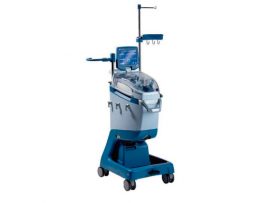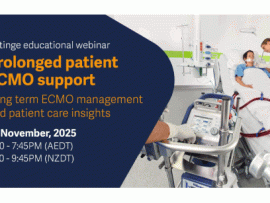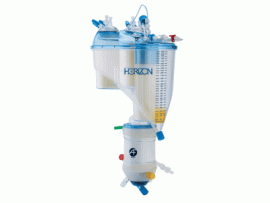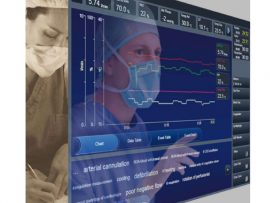Abstract Introduction Partial heart transplantation (PHT) represents a novel and adaptable approach to cardiac surgery, allowing for patient-specific and disease-specific interventions while expanding the donor pool and improving organ stewardship...
Read MoreAbstract Background Extracorporeal membrane oxygenation (ECMO) is a critical, life-sustaining intervention often described as ‘a bridge to nowhere’ due to its transient nature and the ethical complexities it entails. This..
Read MoreAbstract Background This study aimed to analyze the postoperative blood transfusion demand and safety of intraoperative cell salvage (ICS) without leukocyte depletion filters in cesarean sections complicated by placenta previa...
Read MoreAbstract Objective: Coronary artery bypass grafting using cardiopulmonary bypass and cardioplegic arrest is an effective treatment for coronary artery disease. Research suggests supplementing the cardioplegia solution with propofol may be..
Read MoreAbstract Objectives To evaluate whether autologous platelet-rich plasma (aPRP) improves blood conservation and postoperative outcomes in emergency surgery for acute type A aortic dissection (ATAAD). Design Systematic review and meta-analysis..
Read MoreAbstract Background Cardiac surgery-associated acute kidney injury (CSA-AKI) is one of the most frequent and severe complications after cardiac surgery. The association between acute kidney injury and the mismatch between..
Read MoreAbstract Background Cardiac arrest in trauma patients can occur from traumatic or non-traumatic aetiologies. Traditionally, trauma has been regarded a contraindication for extracorporeal life support, particularly extracorporeal cardiopulmonary resuscitation (ECPR)...
Read MoreAbstract Objectives: An increasing number of pediatric centers use the femoral vein in neonates and smaller children to provide venovenous multisite (VVMS) extracorporeal membrane oxygenation (ECMO), but there are no..
Read MoreThe management of patients receiving Extracorporeal Membrane Oxygenation (ECMO) in critical care settings represents can be one of the most demanding aspects of intensive care medicine and nursing care. As..
Read MoreOxigenador Horizon La solución para la reducción máxima de microémbolos (GME). Se adapta a las necesidades pequeñas de Adultos y Pacientes Adultos garantizando un rendimiento adecuado desde 0,5 L/min a..
Read MoreTrilly Infant-Pediatric Diseñado para optimizar la reducción de GME en pacientes pediátricos El oxigenador pediátrico Trilly, gracias a la dinámica de flujo optimizada, garantiza un rendimiento excepcional de 0,5 lpm..
Read MorePRO Cardioplegia, the intentional and temporary arrest of the heart during cardiac surgery, has been a cornerstone of modern heart transplantation, enabling myocardial protection during ischemic periods. Its use dates..
Read MoreAbstract Background Cardiopulmonary bypass is widely used in cardiac surgery but often leads to lung ischemia–reperfusion injury, a major cause of morbidity and mortality. Despite advances in critical care, effective..
Read MoreAbstract Extracorporeal membrane oxygenation (ECMO) is a last resort treatment for children with cardio-respiratory failure. Some of these patients will develop thrombocytopenia-associated multiple organ failure (TAMOF), which is sometimes managed..
Read MoreAbstract Cardiac surgery patients may experience stress and anxiety, negatively impacting recovery. Pharmacological treatments are frequently used but may result in side effects. We aimed to assess the effectiveness of..
Read MoreAbstract Background To evaluate the association between intraoperative end-tidal carbon dioxide (ETCO₂) levels and clinical outcomes in patients undergoing cardiac surgery. Methods This retrospective analysis included patients who underwent cardiac..
Read MoreAbstract Remote ischemic preconditioning (RIPreC) has been regarded as a promising strategy to reduce ischemia-reperfusion injury to the heart and other organs caused by cardiopulmonary bypass. While RIPreC has demonstrated..
Read MoreAbstract Objectives Early prediction is crucial for cardiac surgery-associated acute kidney injury (CSA-AKI). We aimed to develop and validate a simple, clinical- and laboratory-based risk score system for better CSA-AKI..
Read MoreAbstract Introduction Neonatal aortic arch surgery is associated with neurological morbidity of varying severity which is detected and potentially limited through neuroprotective strategies. We conducted a survey of healthcare professionals..
Read MoreAbstract Objectives Extracorporeal Life Support (ECLS) has evolved into an established treatment for severe cardiogenic shock. As most patients have residual antegrade left ventricular output toward the descending aorta that..
Read MoreAbstract Objectives Activated recombinant factor VII (rFVIIa) has been used to treat cardiac surgical bleeding in an off-label manner. Due to the high risk of mortality with ongoing hemorrhage, assessing..
Read MoreAbstract Low cardiac output syndrome (LCOS) is defined by an insufficient cardiac output to meet metabolic demands, leading to tissue hypoperfusion and potential organ dysfunction. Although it affects up to 42%..
Read MoreAbstract Introduction Viscoelastic point-of-care diagnostics are crucial in cardiac surgery. In the FIBTEM assay of rotational thromboelastometry (ROTEM), guidelines suggest target maximum clot firmness values to reduce perioperative bleeding. The..
Read MoreAbstract Background Respiratory management of extremely low gestational age neonates (ELGANs) is a major challenge in neonatal intensive care, as they face high mortality and morbidity due to complications such..
Read MoreAbstract Background Cardiopulmonary bypass (CPB) during cardiac surgery disrupts cerebral hemodynamics, potentially leading to postoperative neurological complications such as delirium. Transcranial Doppler (TCD) offers non-invasive monitoring of cerebral blood flow..
Read MoreAbstract Objective This study evaluated thrombus formation and its impact on outcomes in neonates and early infants undergoing congenital heart surgery. Methods Neonates and early infants (≤90 days) undergoing congenital..
Read MoreAbstract Background/Aim Recent literature suggested that the use of Minimal Invasive Extracorporeal Circulation (MIECC) may mitigate the inflammatory response in patients undergoing cardiac surgery. We aimed to perform a meta-analysis..
Read MoreAbstract Background Goal-directed perfusion (GDP) during cardiopulmonary bypass (CPB) seeks to match oxygen delivery with patient-specific metabolic demand, yet determinants of oxygen demand and dynamics of oxygen extraction ratio (OER)..
Read MoreAbstract Background Mortality in congenital diaphragmatic hernia (CDH) approximates 30 %. Both severe lung hypoplasia and other anomalies contribute to demise regardless of repair and/or extracorporeal membrane oxygenation (ECMO). We..
Read MoreAbstract Introduction: Ensuring radiation safety in healthcare settings is crucial to minimising risks associated with ionising radiation exposure. This study aimed to evaluate the knowledge and behaviours of operating room..
Read More





















